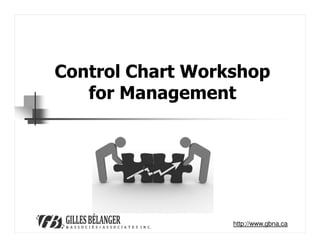
Control chart for Managers
- 1. Control Chart Workshop for Management http://www.gbna.ca
- 2. Learning Objectives At the end of this workshop, you will be able to: Interpret your control chart Explain the benefits of a control chart Would you like to gain something else from this session? © 2012 Gilles Bélanger & Associates Inc. 2
- 3. The Origin of the Control Charts Control Charts were invented by Walter A Shewart while working for Bell Labs in the 20’s. • He developed a theory that there are two components to variation: • Common Cause: random and predictable • Special Cause: non-random and assignable cause that could be internal or external to the system Over the next 50 years, Dr. W. Edwards Deming became the biggest proponent of Shewart’s work. • His definition of Special Cause is: non-random and unusual event external to the system © 2012 Gilles Bélanger & Associates Inc. 3
- 4. Key Discussion Points What is a control chart and what are its components? Why is the control chart important for me and what is it telling me? It provides a clear signal when management intervention is required. © 2012 Gilles Bélanger & Associates Inc. 4
- 5. Shewhart’s contribution Control chart illustrates process behavior over time It’s a special cause detection tool Can also be used as a predictive tool when the process is stable © 2012 Gilles Bélanger & Associates Inc. 5
- 6. Components of a Control Chart Upper and Lower Data Mean control Limit is always are shown. shown They reflect the Voice of the Process. © 2012 Gilles Bélanger & Associates Inc. 6
- 7. Components of a Control Chart Upper and Lower control limits Upper Spec represents limit defined ±3 by standard management deviations. or a third Standard party. deviation is a measure of variation. The data in above control chart are within the control limits. The process is stable and predictable. We can predict there is a 99.7% probability the next data point will be between 4.13 and 5.95). © 2012 Gilles Bélanger & Associates Inc. 7
- 8. Components of a Control Chart Upper Control Limit (ULC): 3σ Lower Control σ= SIGMA-Letter from the Greek alphabet used in Limit (LCL): -3σ statistics as a symbol for standard deviation © 2012 Gilles Bélanger & Associates Inc. 8
- 9. Components of a Control Chart Mean Lower Control Limit Upper Control Limit Normal distribution (symmetrical) : 68% of data points are contained within ±1σ, 95% of data points are contained within ± 2 σ, 99.7% of data points are contained within ± 3 σ (UCL & LCL). © 2012 Gilles Bélanger & Associates Inc. 9
- 10. Components of a Control Chart When all data points are within the Control Limits we have common cause, routine, Normal random distribution variation. Special cause conditions are unusual, non-random events, external to the system. When one or several data points are outside the Control Limits, the process is Out of Control and management attention is required. © 2012 Gilles Bélanger & Associates Inc. 10
- 11. Components of a Control Chart What can you conclude about the profit goal? © 2012 Gilles Bélanger & Associates Inc. 11
- 12. Why is a Control Chart important for me? 1. Allows you to see patterns and trends over time 2. Make a distinction between special causes and common causes of variation 3. May be used as a tool for ongoing control of process 4. Warns you when a problem or a shift in the process has occurred 5. Provides a common language for discussing process performance Control chart is a tool that helps you to effectively monitor process performance metrics and support you and your team in better managing improved processes by validating their stability, predictability and performance. © 2012 Gilles Bélanger & Associates Inc. 12
- 13. Why is a Control Chart important for me? Customers may be How your internal or external. Customer feels the process Happy Happy employees! Stability Predictability Customers! Is your process stable and predictable over Control Chart time? © 2012 Gilles Bélanger & Associates Inc. 13
- 14. What is a Control Chart telling me? Special cause: Special cause: investigate, investigate possible temporary process shift? Common cause: do not react. Control chart shows the “Voice of the Process” and tells you when to keep going or stop and investigate for a special cause! © 2012 Gilles Bélanger & Associates Inc. 14
- 15. What is a Control Chart telling me? Upper and Lower Control Limits are determined by the process and not by management or third party specifications © 2012 Gilles Bélanger & Associates Inc. 15
- 16. What is a Control Chart telling me? BEFORE After your Before any improvement team’s process we have an improvement average wait project, we can time of 11 predict there is minutes a 99.7% probability the next data point AFTER will be between 6.89 and 11.19 minutes. New average is 9 minutes! © 2012 Gilles Bélanger & Associates Inc. 16
- 17. Control Chart benefits Summary No more firefighting. Better resource React only to special management! causes that are outside Happier employees! the Voice of the Process Control Limits! Higher quality of work, no surprises. © 2012 Gilles Bélanger & Associates Inc. 17
- 18. Questions? Please email any question to: gbelanger@gbna.ca © 2012 Gilles Bélanger & Associates Inc. 18
